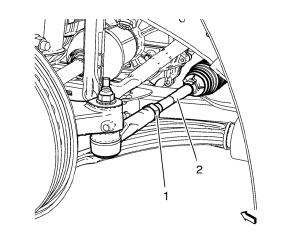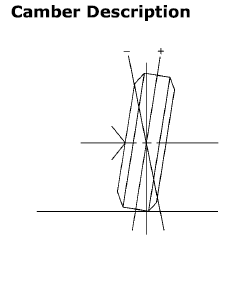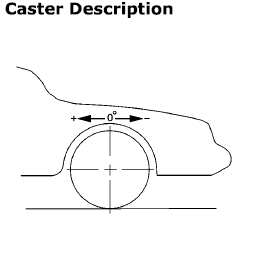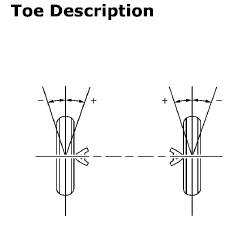Chevrolet Cruze Repair Manual: Wheel Alignment - Steering Wheel Angle and/or Front Toe Adjustment

- Ensure that the steering wheel is set in a straight ahead position.
- Loosen the tie rod jam nut (1).
- Adjust the toe to specification by turning the adjuster (2). Refer to Wheel Alignment Specifications.
Caution: Refer to Fastener Caution in the Preface section.
- Tighten the tie rod jam nut (1) to 35 N·m (26 lb ft).
Rear Caster and Camber Adjustment
The rear caster and camber is not adjustable. If the rear caster and camber angle is not within specifications, inspect for suspension support misalignment or rear suspension damage. Replace any damaged suspension components as necessary.
Rear Camber Adjustment
The rear camber is not adjustable. If the rear camber angle is not within specifications, inspect for suspension support misalignment or rear suspension damage. Replace any damaged suspension components as necessary.
Rear Toe Adjustment
The rear toe is not adjustable. If the rear toe angle is not within specifications, inspect for suspension support misalignment or rear suspension damage. Replace any damaged suspension components as necessary.

Camber is the tilting of the wheels from the vertical when viewed from the front of the vehicle. When the wheels tilt outward at the top, the camber is positive (+). When the wheel tilts inward at the top, the camber is negative (-). The amount of tilt is measured in degrees from the vertical. Camber settings influence the directional control and the tire wear.
Too much positive camber will result in premature wear on the outside of the tire and cause excessive wear on the suspension parts.
Too much negative camber will result in premature wear on the inside of the tire and cause excessive wear on the suspension parts.
Unequal side-to-side camber of one degree or more will cause the vehicle to pull or lead to the side with the most positive camber.

Caster is the tilting of the uppermost point of the steering axis either forward or backward, when viewed from the side of the vehicle. A backward tilt is positive (+) and a forward tilt is negative (-). Caster influences directional control of the steering but does not affect the tire wear. Caster is affected by the vehicle height, therefore it is important to keep the body at its designed height. Overloading the vehicle or a weak or sagging rear spring will affect caster. When the rear of the vehicle is lower than its designated trim height, the front suspension moves to a more positive caster. If the rear of the vehicle is higher than its designated trim height, the front suspension moves to a less positive caster.
With too little positive caster, steering may be touchy at high speed and wheel returnability may be diminished when coming out of a turn.
If one wheel has more positive caster than the other, that wheel will pull toward the center of the vehicle. This condition will cause the vehicle to pull or lead to the side with the least amount of positive caster.

Toe is a measurement of how much the front and/or rear wheels are turned in or out from a straight-ahead position. When the wheels are turned in, toe is positive (+). When the wheels are turned out, toe is negative (-). The actual amount of toe is normally only a fraction of a degree. The purpose of toe is to ensure that the wheels roll parallel.
Toe also offsets the small deflections of the wheel support system that occur when the vehicle is rolling forward. In other words, with the vehicle standing still and the wheels set with toe-in, the wheels tend to roll parallel on the road when the vehicle is moving.
Improper toe adjustment will cause premature tire wear and cause steering instability.
 Wheel Alignment Measurement
Wheel Alignment Measurement
Steering and vibration complaints are not always the result of improper
alignment. One possible cause is wheel and tire imbalance.
Another possibility is tire lead due to worn or improperly manuf ...
 HVAC System
HVAC System
Specifications
...
Other materials:
Interior Lamps Dimming
This group includes lamps which may dim. This group may use a combination of
vacuum fluorescent illumination, LEDs and incandescent
lamps
HVAC control module, head assembly
Rear HVAC control module, head assembly
Radio
Rear seat audio
The instrument panel cluster
The PRNDL lamp, wit ...
Emergency
With Automatic Crash Response, the built-in system can automatically connect
to help in most crashes, even if help cannot be requested.
Press to connect to an Emergency
Advisor. GPS technology is used to identify the vehicle location and can provide
critical information to emergency personne ...
Vehicle Alarm System
This vehicle has a theft alarm system.
Arming the System
To arm the system, use the power door lock switch or the RKE transmitter to lock
the vehicle while exiting with the vehicle turned off.
The alarm arms after about 30 seconds after all the doors have been closed.
Press again and the syst ...
